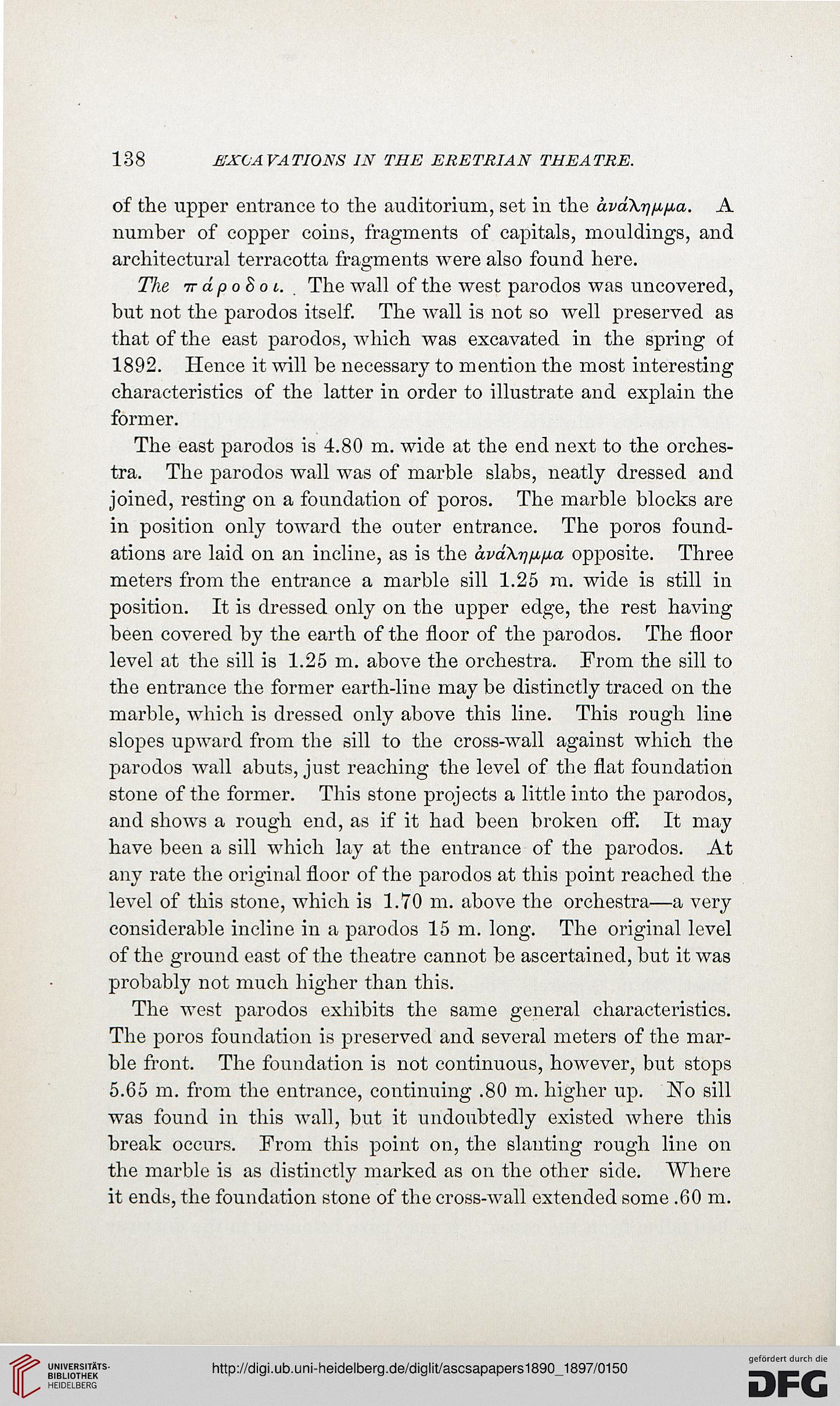138
EXCAVATIONS IN THE ERETRIAN THEATRE.
of the upper entrance to the auditorium, set in the avdXrj/j,/j,a. A
number of copper coins, fragments of capitals, mouldings, and
architectural terracotta fragments were also found here.
The 7r a p o 8 o t. . The wall of the west parodos was uncovered,
but not the parodos itself. The wall is not so well preserved as
that of the east parodos, which was excavated in the spring of
1892. Hence it will be necessary to mention the most interesting
characteristics of the latter in order to illustrate and explain the
former.
The east parodos is 4.80 m. wide at the end next to the orches-
tra. The parodos wall was of marble slabs, neatly dressed and
joined, resting on a foundation of poros. The marble blocks are
in position only toward the outer entrance. The poros found-
ations are laid on an incline, as is the dvdXrj/jL/jia opposite. Three
meters from the entrance a marble sill 1.25 m. wide is still in
position. It is dressed only on the upper edge, the rest having
been covered by the earth of the floor of the parodos. The floor
level at the sill is 1.25 m. above the orchestra. From the sill to
the entrance the former earth-line may be distinctly traced on the
marble, which is dressed only above this line. This rough line
slopes upward from the sill to the cross-wall against which the
parodos wall abuts, just reaching the level of the flat foundation
stone of the former. This stone projects a little into the parodos,
and shows a rough end, as if it had been broken off. It may
have been a sill which lay at the entrance of the parodos. At
any rate the original floor of the parodos at this point reached the
level of this stone, which is 1.70 m. above the orchestra—a very
considerable incline in a parodos 15 m. long. The original level
of the ground east of the theatre cannot be ascertained, but it was
probably not much higher than this.
The west parodos exhibits the same general characteristics.
The poros foundation is preserved and several meters of the mar-
ble front. The foundation is not continuous, however, but stops
5.65 m. from the entrance, continuing .80 m. higher up. No sill
was found in this wall, but it undoubtedly existed where this
break occurs. From this point on, the slanting rough line on
the marble is as distinctly marked as on the other side. "Where
it ends, the foundation stone of the cross-wall extended some .60 m.
EXCAVATIONS IN THE ERETRIAN THEATRE.
of the upper entrance to the auditorium, set in the avdXrj/j,/j,a. A
number of copper coins, fragments of capitals, mouldings, and
architectural terracotta fragments were also found here.
The 7r a p o 8 o t. . The wall of the west parodos was uncovered,
but not the parodos itself. The wall is not so well preserved as
that of the east parodos, which was excavated in the spring of
1892. Hence it will be necessary to mention the most interesting
characteristics of the latter in order to illustrate and explain the
former.
The east parodos is 4.80 m. wide at the end next to the orches-
tra. The parodos wall was of marble slabs, neatly dressed and
joined, resting on a foundation of poros. The marble blocks are
in position only toward the outer entrance. The poros found-
ations are laid on an incline, as is the dvdXrj/jL/jia opposite. Three
meters from the entrance a marble sill 1.25 m. wide is still in
position. It is dressed only on the upper edge, the rest having
been covered by the earth of the floor of the parodos. The floor
level at the sill is 1.25 m. above the orchestra. From the sill to
the entrance the former earth-line may be distinctly traced on the
marble, which is dressed only above this line. This rough line
slopes upward from the sill to the cross-wall against which the
parodos wall abuts, just reaching the level of the flat foundation
stone of the former. This stone projects a little into the parodos,
and shows a rough end, as if it had been broken off. It may
have been a sill which lay at the entrance of the parodos. At
any rate the original floor of the parodos at this point reached the
level of this stone, which is 1.70 m. above the orchestra—a very
considerable incline in a parodos 15 m. long. The original level
of the ground east of the theatre cannot be ascertained, but it was
probably not much higher than this.
The west parodos exhibits the same general characteristics.
The poros foundation is preserved and several meters of the mar-
ble front. The foundation is not continuous, however, but stops
5.65 m. from the entrance, continuing .80 m. higher up. No sill
was found in this wall, but it undoubtedly existed where this
break occurs. From this point on, the slanting rough line on
the marble is as distinctly marked as on the other side. "Where
it ends, the foundation stone of the cross-wall extended some .60 m.




